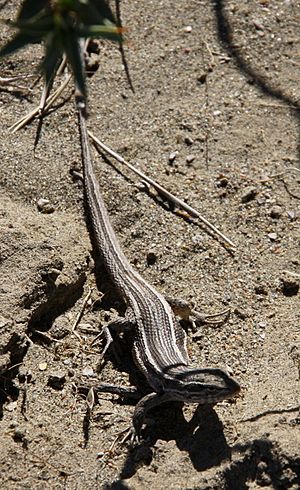Graceful tree iguana facts for kids
Quick facts for kids Graceful tree iguana |
|
|---|---|
 |
|
| Conservation status | |
| Scientific classification | |
| Genus: |
Liolaemus
|
| Species: |
gracilis
|
The graceful tree iguana (Liolaemus gracilis) is a type of lizard that belongs to the family called Liolaemidae. This lizard is found naturally in Argentina, a country in South America. It was first described by a scientist named Thomas Bell in 1843.
Contents
About the Graceful Tree Iguana
The graceful tree iguana is a small to medium-sized lizard. It is known for its slender body, which helps it move quickly and easily. These lizards often have patterns of spots, stripes, or patches on their skin. Their colors can vary, helping them blend in with their surroundings. This is a great way to hide from predators or sneak up on prey.
What Does It Look Like?
Graceful tree iguanas usually have a body length of about 2 to 3 inches (5 to 7.5 cm), not including their tail. Their tail can be even longer than their body. They have strong legs and sharp claws, which are perfect for climbing trees and rocks. Their scales are small and smooth, giving them a sleek appearance. The exact colors and patterns can differ between individual lizards, even within the same species.
Where Does It Live?
This lizard species is native to Argentina. It lives in different types of environments, often preferring places with trees or rocky areas. These habitats provide plenty of places to hide, bask in the sun, and find food. They can be found in forests, woodlands, and even some shrublands. The graceful tree iguana is well-adapted to its South American home.
Its Home in Argentina
Argentina has a wide range of climates and landscapes. The graceful tree iguana thrives in areas where it can find shelter and warmth. They are often seen on tree trunks, branches, or sunning themselves on rocks. Their ability to climb makes them very good at living in these varied environments.
What Does It Eat?
Like many lizards, the graceful tree iguana is an insectivore. This means its main diet consists of insects. They hunt for small bugs, spiders, and other invertebrates. They are active hunters, using their keen eyesight to spot prey. Their quick movements allow them to catch insects swiftly.
Hunting for Food
These lizards spend their days searching for food. They might wait patiently for an insect to pass by, or they might actively chase after it. Their diet helps control insect populations in their natural habitat.
How Does It Reproduce?
Graceful tree iguanas reproduce by laying eggs. After mating, the female lizard will find a safe place to lay her eggs. This is usually in soft soil or under rocks, where the eggs will be protected. The eggs develop over time, and eventually, tiny baby lizards hatch.
Life Cycle of the Lizard
Once hatched, the young lizards are independent. They look like smaller versions of the adults and must find their own food and shelter. They grow over time, shedding their skin as they get bigger. This process is called molting. As they mature, they will be able to reproduce themselves, continuing the life cycle.
Conservation Status
The graceful tree iguana is currently listed as "Least Concern" by the International Union for Conservation of Nature (IUCN). This means that its population is stable and not currently facing a high risk of extinction. However, it is always important to protect natural habitats to ensure all species can thrive.
See also
- In Spanish: Lagartija grácil para niños
Images for kids



